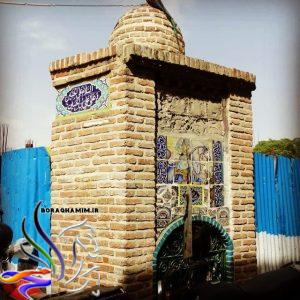Saqaqhanas :An oasis of spirituality and sacrifice in the back alleys of Iran
Buraq Hamim’s artistic encyclopedia – Saqaqhana, a familiar name in the history and culture of Iran, was a reminder of the small and intimate spaces in public roads that residents and businessmen built to give water to thirsty passers-by, especially in the excruciating heat of summer.
But Saqaqhana was not only a place to quench thirst, but over time it became a symbol of sacrifice and martyrdom, religion and spirituality, and played an important role in Shiite rituals and mourning ceremonies, especially in the month of Muharram.
Rooted in charity:
The foundation of the tavern was built on charity and benevolence. Benefactors and philanthropists sought to obtain divine rewards by building these spaces, and in this way, they poured clear water on the palates of thirsty passers-by.
Architecture and decorations:
Teahouses usually consisted of a small space with a niche to place a water container and some cups. These spaces were given a beautiful and spiritual effect with exquisite tiling, mirror work, and religious decorations such as pictures of Imam Hussein (a.s.) and Hazrat Abul Fazl Abbas (a.s.) and poems and prayers.

Role in the Imam Hossein mourning ceremony:
With the passage of time, Saqqakhanehs were increasingly tied to the mourning rituals of the month of Muharram and honoring the memory of Imam Hussain (a.s.) and his noble companions, especially Hazrat Abul Fazl Abbas (a.s.).
Hazrat Abul Fazl Abbas (a.s.) as a scholar and butler of Karbala, in the Karbala incident, with his dedication and sacrifice, brought water to the tent of Imam Hussain (a.s.) and his companions and prevented them from thirsting in the scorching heat of the desert.
For this reason, Saqqakhanehs were set up in the mourning routes to commemorate this sacrifice and people paid their respects by lighting candles and prayers and benefited from its spiritual blessings.
Social functions:
In addition to the religious aspect, saqaqhanas also had social functions. These spaces served as a place for interaction and conversation between people, especially in old neighborhoods.
Also, women and girls, who at that time had more restrictions on being in the community, could gather in the taverns and exchange opinions and greetings.
Saqaqhanas today:
Today, with the expansion of water supply networks, there is no longer a need for drinking fountains to quench thirst. However, these spaces are still culturally and religiously important for many Iranians.
Some of the old and historical teahouses have been preserved and restored as cultural heritage and have become an attraction for tourists.
Saqaqhanas are a reminder of sacrifice and sacrifice, religion and spirituality, and solidarity and cooperation in Iranian culture and have a lasting role in the history and identity of this land.
The first Saqaqhane
It is difficult to accurately determine the first Saqaqhana and its founder in the history of Iran due to the lack of reliable oral and documentary sources. However, some researchers believe that the first drinking fountains were built in the Safavid period and simultaneously with the spread of the Shia religion in Iran.
Some sources also report the existence of saqaqhanas in the periods before the Safavid period, such as the Ilkhanid period. But there is no definite evidence to prove this claim.
There is no detailed information about the founders of the first breweries. Probably local benefactors and benefactors, such as rich people, tradesmen, or religious leaders, played a role in the construction of these spaces. Also, some breweries were built by rulers and sultans.
Despite the existing ambiguities, it can be said that saqaqhanas are rooted in the culture of charity and benevolence in Iran and have long been known as a symbol of sacrifice, religion and spirituality in this land.
Famous Saqaqhane
Among the most famous taverns in Iran are Sheikh Safiuddin Ardabili tomb tavern in Ardabil dating from the 16th century, Kuche Dabag Khane tavern in Yazd dating from 1517, Azizullah tavern next to the Juma Mosque in Isfahan built during the reign of Shah Suleiman between 1666 and 1694 and Ismail Talai tavern built by Nader Shah Afshar in Imam Reza shrine in Mashhad between 1736 and 1747. There are more than 290 taverns in Tehran, and Khodabande Lo tavern is the only illustrated tavern in Tehran that has remained from the Qajar period, which is considered one of the most unique historical monuments of Tehran. In Tehran (Old Tehran) in terms of architecture and audience, Abbas Karbalai taverns, Nowruz Khan, Sheikh Hadi Najmabadi taverns, Aine tavern and Khodabande Lo illustrated taverns were very famous. A tavern is also located in front of Imamzade Seyyed Ishaq’s tomb in Khudabandeh Lo Street, which was apparently built for this blessed place. This tavern is more than 600 years old and has been falling into ruin for some time due to the neglect of the authorities.







More Stories
Al-Muraqabat (book)
What is an emoji?
Modern building and traditional architecture of Iran